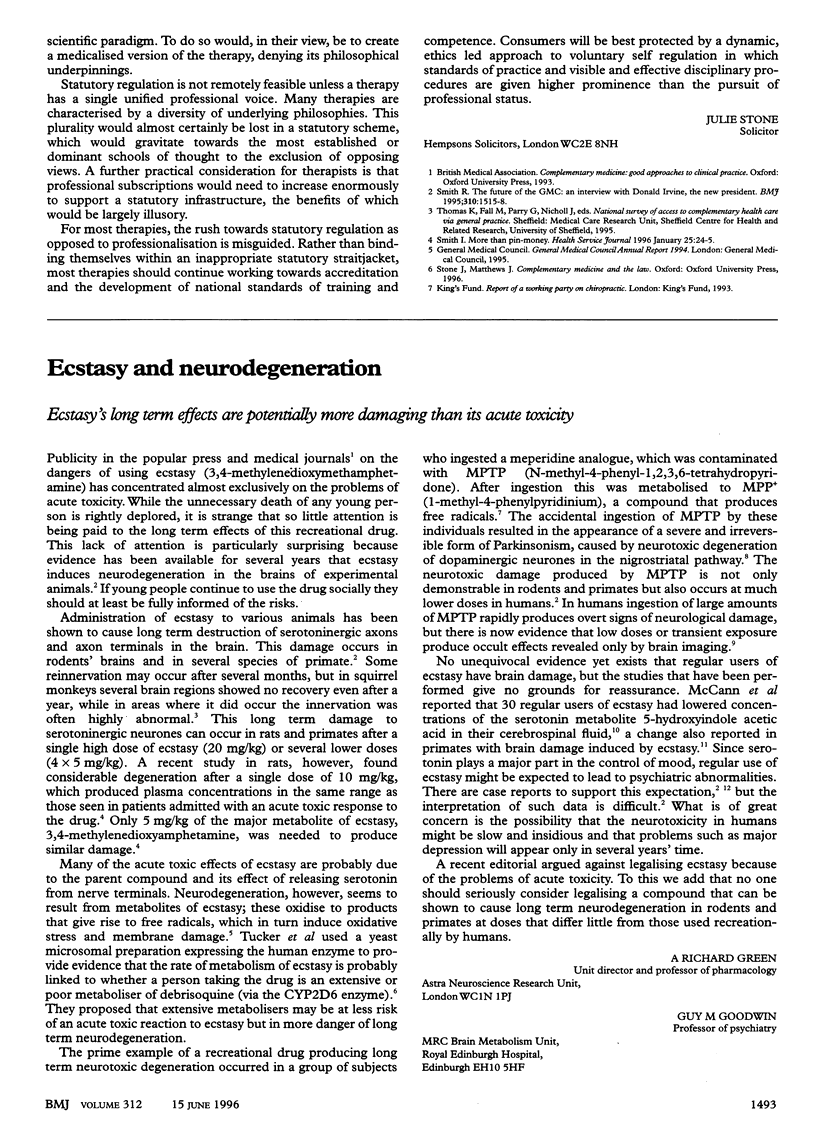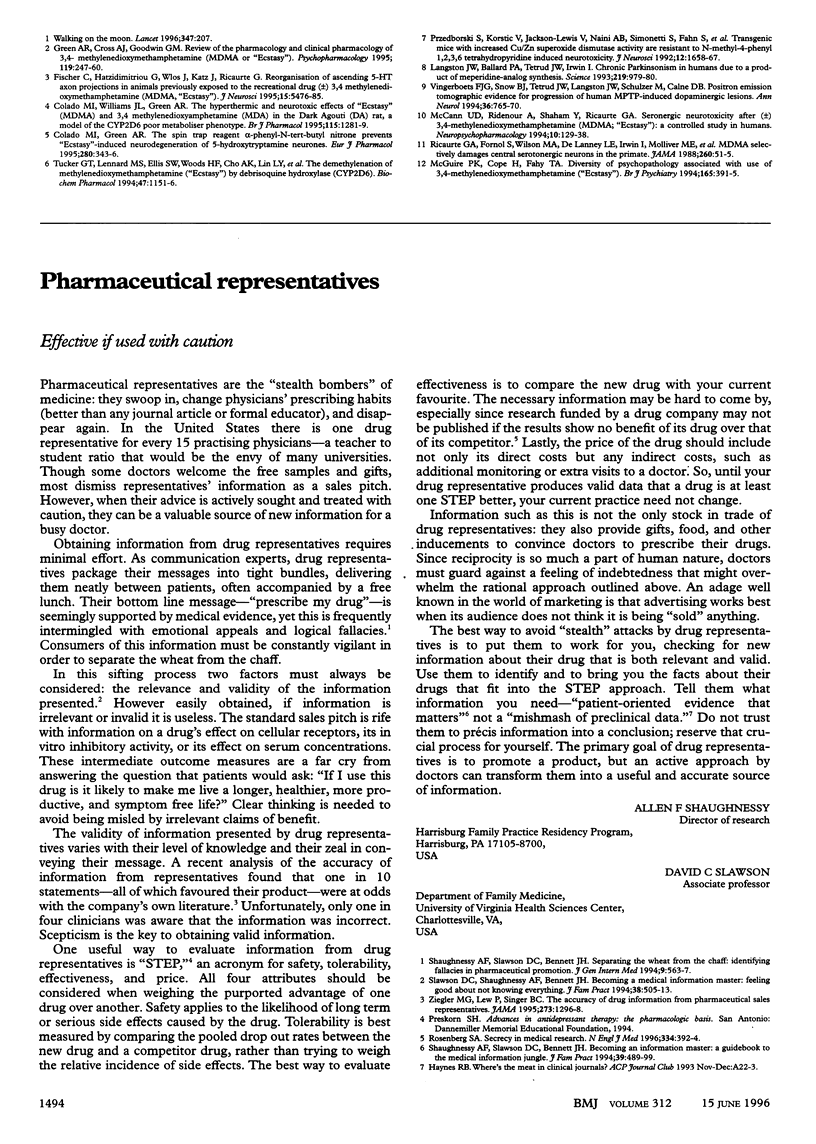Full text
PDF

Selected References
These references are in PubMed. This may not be the complete list of references from this article.
- Colado M. I., Green A. R. The spin trap reagent alpha-phenyl-N-tert-butyl nitrone prevents 'ecstasy'-induced neurodegeneration of 5-hydroxytryptamine neurones. Eur J Pharmacol. 1995 Jul 14;280(3):343–346. doi: 10.1016/0014-2999(95)00298-y. [DOI] [PubMed] [Google Scholar]
- Colado M. I., Williams J. L., Green A. R. The hyperthermic and neurotoxic effects of 'Ecstasy' (MDMA) and 3,4 methylenedioxyamphetamine (MDA) in the Dark Agouti (DA) rat, a model of the CYP2D6 poor metabolizer phenotype. Br J Pharmacol. 1995 Aug;115(7):1281–1289. doi: 10.1111/j.1476-5381.1995.tb15037.x. [DOI] [PMC free article] [PubMed] [Google Scholar]
- Fischer C., Hatzidimitriou G., Wlos J., Katz J., Ricaurte G. Reorganization of ascending 5-HT axon projections in animals previously exposed to the recreational drug (+/-)3,4-methylenedioxymethamphetamine (MDMA, "ecstasy"). J Neurosci. 1995 Aug;15(8):5476–5485. doi: 10.1523/JNEUROSCI.15-08-05476.1995. [DOI] [PMC free article] [PubMed] [Google Scholar]
- Green A. R., Cross A. J., Goodwin G. M. Review of the pharmacology and clinical pharmacology of 3,4-methylenedioxymethamphetamine (MDMA or "Ecstasy"). Psychopharmacology (Berl) 1995 Jun;119(3):247–260. doi: 10.1007/BF02246288. [DOI] [PubMed] [Google Scholar]
- Langston J. W., Ballard P., Tetrud J. W., Irwin I. Chronic Parkinsonism in humans due to a product of meperidine-analog synthesis. Science. 1983 Feb 25;219(4587):979–980. doi: 10.1126/science.6823561. [DOI] [PubMed] [Google Scholar]
- McCann U. D., Ridenour A., Shaham Y., Ricaurte G. A. Serotonin neurotoxicity after (+/-)3,4-methylenedioxymethamphetamine (MDMA; "Ecstasy"): a controlled study in humans. Neuropsychopharmacology. 1994 Apr;10(2):129–138. doi: 10.1038/npp.1994.15. [DOI] [PubMed] [Google Scholar]
- McGuire P. K., Cope H., Fahy T. A. Diversity of psychopathology associated with use of 3,4-methylenedioxymethamphetamine ('Ecstasy') Br J Psychiatry. 1994 Sep;165(3):391–395. doi: 10.1192/bjp.165.3.391. [DOI] [PubMed] [Google Scholar]
- New Targets for Long Acting Drugs Involving Translocation to the Nucleus. Proceedings of the 6th Biochemical Pharmacology Symposium. Oxford, 22-23 July 1993. Dedicated to Professor Peter Alexander PhD, Dsc. 1922-1993. Biochem Pharmacol. 1994 Jan 13;47(1):1–154. [PubMed] [Google Scholar]
- Przedborski S., Kostic V., Jackson-Lewis V., Naini A. B., Simonetti S., Fahn S., Carlson E., Epstein C. J., Cadet J. L. Transgenic mice with increased Cu/Zn-superoxide dismutase activity are resistant to N-methyl-4-phenyl-1,2,3,6-tetrahydropyridine-induced neurotoxicity. J Neurosci. 1992 May;12(5):1658–1667. doi: 10.1523/JNEUROSCI.12-05-01658.1992. [DOI] [PMC free article] [PubMed] [Google Scholar]
- Ricaurte G. A., Forno L. S., Wilson M. A., DeLanney L. E., Irwin I., Molliver M. E., Langston J. W. (+/-)3,4-Methylenedioxymethamphetamine selectively damages central serotonergic neurons in nonhuman primates. JAMA. 1988 Jul 1;260(1):51–55. [PubMed] [Google Scholar]
- Vingerhoets F. J., Snow B. J., Tetrud J. W., Langston J. W., Schulzer M., Calne D. B. Positron emission tomographic evidence for progression of human MPTP-induced dopaminergic lesions. Ann Neurol. 1994 Nov;36(5):765–770. doi: 10.1002/ana.410360513. [DOI] [PubMed] [Google Scholar]


